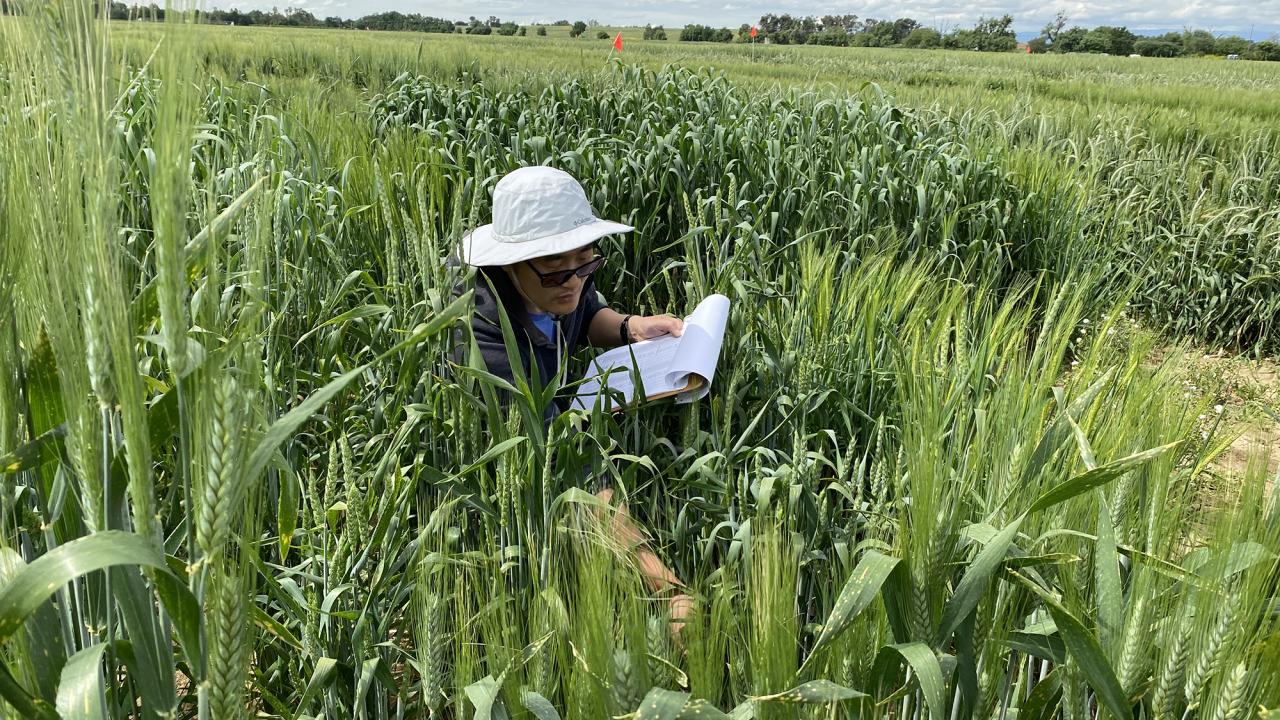Dwarfing genes in cereal crops made the Green Revolution of the 1960s possible, but they have limitations. Scientists at UC Davis have discovered a gene that can overcome some of those limitations in wheat by controlling plant height, while boosting yield in fields where water is less plentiful. Their discovery was published May 3 in the Proceedings of the National Academy of Sciences.
The new gene, dubbed PLATZ1, can be used to fine-tune the height of wheat plants. Green Revolution wheat grows shorter than its ancestors, so the plant can spend more energy producing grains. But in some environmental conditions where water is scant, the slightly taller PLATZ1 dwarf plants may produce more grains.
The new gene also results in longer coleoptiles – the protective sheaths that cover the emerging shoots. The longer coleoptiles of the PLATZ1 dwarf plants allow seeds to be planted deeper, giving plants access to moisture deeper in the soil – a plus for drier areas, said lead author Junli Zhang, an assistant project scientist in the UC Davis Department of Plant Sciences.
“Wheat dwarfing genes that were essential for the Green Revolution are insensitive to the plant growth hormone gibberellin (gibberellic acid, or GA), which results in some limitations,” said Jorge Dubcovsky, distinguished professor in plant sciences, whose lab produced the discovery. “This has triggered new research interest in identifying and testing new dwarfing genes that are sensitive to GA. The PLATZ1 dwarfing gene is sensitive to GA and can be used to replace the GA-insensitive dwarf genes of the Green Revolution.”
From short coleoptile to longer coleoptile
A gene that was key to the Green Revolution is RHT1, named for “reduced height 1.” This gene makes wheat grow shorter, and it also controls the length of the coleoptile. In Green Revolution wheat, the coleoptiles are also short.
When water is plentiful, there’s no problem. But with less irrigation, the seeds need to be planted deeper to reach moisture below, so coleoptiles need to grow longer to emerge from the soil. In this case, the hormone GA would signal the sheath to grow a little longer – but Green Revolution wheat ignores the signal.
The PLATZ1 gene solves that problem. The mutated version reduces overall plant height without affecting coleoptile length. The plant responds to the GA signal, growing a longer coleoptile, and allowing the more-deeply-planted wheat to reach deeper moisture, Zhang said.
In addition, the GA hormone promotes plant growth, so dwarf plants that are sensitive to GA also can grow faster and produce more green tissue, or biomass, which is essential to support higher yields, Dubcovsky added.
PLATZ1 also helps plants resist lodging – when stems fall over at ground level, typically bent by wind. Lodging leads to major losses of grain production around the world, and resistance to it was another essential improvement bred into Green Revolution plants.
Field tests in future
The Dubcovsky team has identified five natural variations of the PLATZ1 gene that lead to loss of function or reduced function. These variations can be used to modulate wheat plant height to different levels. The team plans to grow wheat with different combinations of GA-sensitive genes to see which ones produce the optimum height and biomass in different conditions, Zhang said.
The discovery builds on the work of another Dubcovsky lab colleague, Ph.D. student Youngjun Mo, Zhang said.
Media Resources
Wheat plant height locus RHT25 encodes a PLATZ transcription factor that interacts with DELLA (RHT1) (PNAS)
Trina Kleist is a writer in the UC Davis Department of Plant Sciences.
